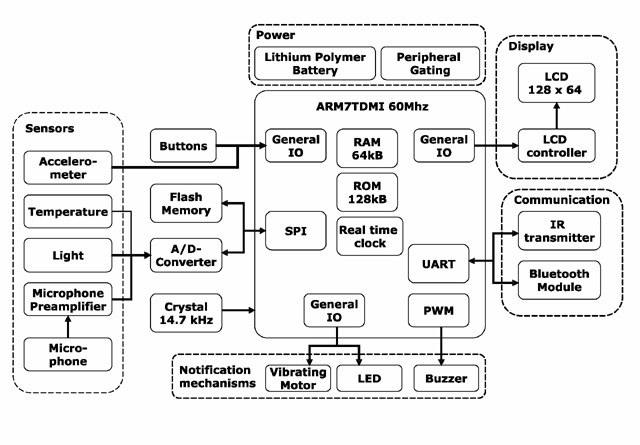Hardware Architecture

The eWatch hardware architecture consists of: the main CPU, sensors, power control, notification mechanisms, and wireless communication. The main CPU is a Philips LPC2106 ARM7TDMI microcontroller with 128Kb of internal FLASH and 64Kb of RAM. The LPC2106 is a 32bit processor capable of software controlled CPU scaling up to 60Mhz. eWatch communicates wirelessly using a SMARTM Bluetooth module and an infrared data port for control of devices such as a television.
Sensor data is acquired using an external TLV1544 10bit ADC and can be stored in a 1Mb external FLASH device. eWatch is capable of sensing temperature, light, two axes of acceleration and audio at user controllable sampling intervals up to 100Khz. A MAX4061 amplifier is used for audio conditioning. We use an ADXL202 MEMs accelerometer to measure the planar acceleration of the user's hand. The user can be notified using a 128x64 pixel display, an LED, vibrating motor and tone generating buzzer. Three push buttons are distributed around the outside of the housing in the standard configuration of a digital watch.
eWatch is powered by a 3.6 volt 700mAh rechargeable lithium polymer battery with a linear regulator active during peak voltages and a DC to DC voltage pump as the battery drains.
- ARM7 processor (32-bit, 80 Mhz,64kb RAM, 128kb Flash)
- Flash memory (1MB)
- 10 bit ADC
- Sensors
- microphone
- dual axis accelerometer
- light sensor
- skin temperature sensor
- three buttons
- Notification
- Vibration Motor
- Audio Alert
- 128x64 monochrome LCD display, blue luminescent backlight
- LED
- Communication
- Bluetooth
- IR output
- RS232
- Power
- 700mAh Lithium Polymer Battery
- 2 Day Battery Life
- Recharges in 1 hour
- CPU Frequency Scaling
- Battery Monitoring
- Power Gating for all peripherals
